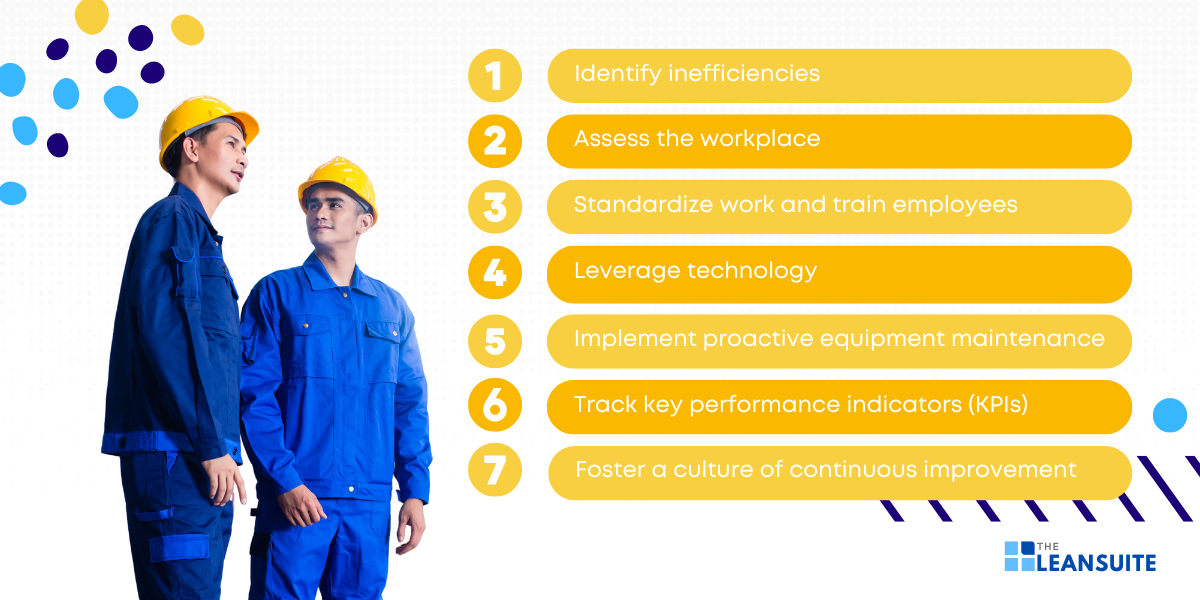Manufacturing businesses across the world share a common goal: to continually improve production efficiency in their factories. This relentless pursuit is driven by the need to reduce costs, improve product quality, and gain and maintain an edge over their competitors.
While the strategies to achieve higher efficiency can vary widely depending on the specific industry and scale of operations, there are several universally applicable methods that can help you streamline your processes.
In this blog post, we will explore some of the most effective strategies that can significantly boost production efficiency.
What is production efficiency?
Production efficiency, or manufacturing efficiency, refers to the optimal use of resources, such as time, labor, and materials, to achieve the highest possible output of high-quality products. It is crucial for manufacturing success because it enables companies to produce goods more cost-effectively. Thereby, reducing waste and minimizing expenses.
By improving your plant’s production efficiency, you can enhance your productivity, allowing you to meet customer demand more swiftly and reliably. This, in turn, boosts your competitiveness in the market, as you can offer better products at lower prices.
Ultimately, increased production efficiency can drive revenue growth. This is because companies are able to produce more with fewer resources, providing a sustainable path to long-term success.
What’s the difference between manufacturing efficiency and manufacturing productivity?
Manufacturing efficiency and productivity are two important concepts in manufacturing, each focusing on different aspects of the production process.
Manufacturing efficiency refers to the quality and effectiveness of the production process, emphasizing the optimal use of time and resources to produce goods. What’s more, it’s about minimizing waste, reducing unplanned downtime, and ensuring that each step in the production line adds value without unnecessary expenditure of materials or labor.
On the other hand, manufacturing productivity is a measure of the quantity of goods produced within a given timeframe, with less emphasis on the resources utilized.
While high manufacturing productivity indicates a high output rate, it doesn’t necessarily reflect how efficiently resources are being used. In essence, achieving high manufacturing efficiency ensures that resources are used wisely and sustainably, whereas high manufacturing productivity focuses on maximizing output, often at the potential cost of increased resource consumption.
Balancing both is crucial for a sustainable and profitable manufacturing plant operation.
Benefits of improving production efficiency
Improving production efficiency offers several substantial benefits for businesses and industries. Here are four key advantages:
Cost reduction
Enhancing production efficiency often leads to a significant reduction in operating costs. By streamlining processes, minimizing waste, and optimizing resource utilization, you can lower your expenses on materials, labor, and energy. Consequently, this cost savings can be reinvested into the business to drive growth, innovation, and competitive advantage.
Increased output
More efficient production processes enable you to produce more goods in the same amount of time, or even less. This increase in output can help meet higher demand without the need for additional resources or significant capital investment. In addition, it allows you to scale up operations quickly and effectively. Thus, improving overall market presence and profitability.
Improved quality
Efficiency improvements often involve the adoption of better technologies and methodologies that enhance product quality. Consistently high-quality products reduce the rate of defects and returns, leading to higher customer satisfaction and loyalty. Moreover, maintaining superior quality standards can distinguish you from your competitors, boosting your reputation and market share.
Environmental sustainability
Efficient production processes typically involve reducing waste and optimizing production flow through the use of raw materials and energy. This not only cuts costs, but also minimizes the environmental footprint of manufacturing activities. Adopting sustainable practices can improve your company’s public image, comply with regulatory requirements, and contribute to long-term ecological balance, making it a socially responsible business choice.
How to improve production efficiency
As mentioned previously, improving efficiency and enhancing productivity are critical to staying competitive and profitable.
This section will explore a variety of strategies designed to improve production efficiency, providing you with practical steps to optimize your operations.
From implementing a culture of continuous improvement to cutting-edge technology implementations, these approaches will not only streamline your processes, but also boost efficiency and elevate the overall performance of your production line.

1. Identify inefficiencies
Improving efficiency begins with a thorough analysis of the entire manufacturing process to identify bottlenecks, waste, and areas for improvement.
Bottlenecks, or points where the flow of production is slowed or halted, can be uncovered through careful monitoring and data collection, allowing for targeted interventions such as equipment upgrades or process reconfigurations.
Waste, whether it be time, materials, or labor, can be minimized by implementing Lean manufacturing principles that focus on streamlining operations and eliminating non-value-added activities. Additionally, continuous improvement methodologies, such as Six Sigma or Kaizen, can be employed to regularly assess and enhance various aspects of the manufacturing process.
2. Assess the workplace
Assessing the workplace to improve production efficiency involves a comprehensive evaluation of several key factors. For instance, shop floor layout, equipment, and workforce allocation.
Start by examining the physical layout of your shop floor to ensure it promotes smooth workflow and minimizes unnecessary movement or bottlenecks. Next, evaluate the equipment being used—consider its condition, suitability for tasks, and whether newer technology could enhance productivity. Finally, carefully examine workforce allocation to ensure that employees are optimally assigned based on their skills and the demands of the tasks at hand.
By identifying areas where improvements can be made, such as upgrading outdated machinery, reorganizing workstations for better ergonomics, or redistributing tasks to leverage employee strengths, you can create a more efficient and productive work environment.
3. Standardize work and train employees
Improving efficiency in manufacturing operations can be significantly achieved by standardizing work processes, which helps reduce errors and enhance product quality. In essence, by establishing clear, consistent procedures, employees can follow a well-defined path that minimizes variability and ensures uniformity in the production lines.
You should also provide interactive and hands-on employee training as this is essential for skill development and adaptation to new processes. What’s more, this type of training not only reinforces learning through practical experience, but also empowers employees to confidently handle tasks and troubleshoot issues. Consequently, this leads to smoother operations and higher overall productivity.
4. Leverage technology
Improving efficiency in your manufacturing process can be significantly enhanced by leveraging advanced technology.
Manufacturing software
One way is through the implementation of manufacturing software. By integrating comprehensive systems that streamline various production processes—such as production planning, customer relationship management, workforce management, inventory management, enterprise resource planning, and supply chain management—you can create a more cohesive and responsive operational environment.
Lean enablement software
You can also opt to adopt a Lean enablement software, also known as a Lean manufacturing software, like LeanSuite as it will specifically help to embed Lean process management principles into your workflow. This type of software helps streamline production workflows, eliminate waste, and optimize resource utilization.
By providing real-time data analytics and process automation, a Lean enablement software enables you to identify bottlenecks, monitor performance, and quickly implement corrective actions. Additionally, it fosters better communication and coordination among teams. This ensures that everyone is aligned towards continuous improvement and operational excellence.
5. Implement proactive equipment maintenance
Unexpected equipment downtime is one of the biggest causes of manufacturing inefficiency. For example, it leads to lost production time, missed deadlines, and ultimately, reduced revenue. Despite its significant impact, many of these breakdowns are preventable with the implementation of a robust preventative maintenance schedule.
By regularly inspecting and servicing equipment, potential issues can be identified and addressed before they result in costly downtime. This proactive approach not only enhances the reliability of machinery, but also ensures a smoother, more efficient manufacturing process.
Consequently, investing in preventive maintenance, is a strategic move to minimize disruptions, optimize productivity, and safeguard against revenue-killing delays.
6. Track key performance indicators (KPIs)
Tracking key performance indicators (KPIs) such as machine downtime rate, percentage of planned maintenance, downtime to operating time, capacity utilization, first pass yield, overall equipment effectiveness (OEE), manufacturing cost per unit, material yield variance, maintenance cost per unit, and overtime rate is essential to measure and improve production efficiency. These KPIs provide a comprehensive view of the production process, highlighting areas that require attention and optimization.
By consistently monitoring these metrics, you can identify patterns and root causes of inefficiencies. For instance, high machine downtime rates may indicate the need for better maintenance practices or equipment upgrades, while a low first pass yield can point to quality control issues.
In short, using data analysis, you can determine the next steps to eliminate bottlenecks, streamline processes, and ultimately reach maximum efficiency. This data-driven approach ensures that decisions are based on factual insights rather than assumptions. Thus, leading to more effective and sustainable improvements in production performance.
7. Foster a culture of continuous improvement
Improving manufacturing efficiency can be significantly achieved by fostering a culture of continuous improvement. This begins with creating an environment where employees feel empowered and encouraged to suggest enhancements and provide constructive feedback on production processes.
By creating an environment that values and implements employee suggestions, manufacturers can tap into the collective expertise and frontline insights of their workforce. This, in turn, leads to innovative solutions and refined manufacturing processes.
Additionally, continuously monitoring and analyzing production data is crucial for identifying inefficiencies and areas for improvement. This data-driven approach helps in making informed decisions and implementing targeted strategies that enhance productivity and reduce operational costs.
Ultimately, the synergy of an engaged workforce and diligent data analysis propels a whole manufacturing facility toward greater efficiency and sustained success.





